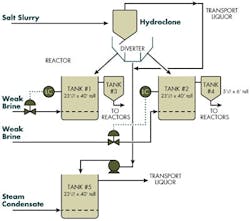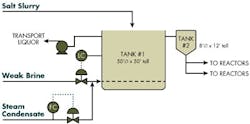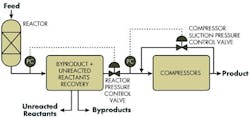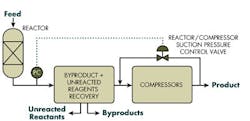Streamline Your Chemical Process
Some chemical makers are missing opportunities to reduce operating costs and increase profits because they aren’t striving to re-engineer and streamline their processes. This doesn’t mean starting from scratch. Instead, a plant often can achieve substantial benefits through simplified steps that do more and work better with less complexity.
The KISS — Keep It Simple and Straightforward — strategy is one of the most effective yet underutilized approaches to optimize a chemical process that has become complex over time. The need for increased capacity, reduced unit cost and equipment replacement often should prompt a fresh look at the whole process.
Figure 1. Complexities, including sequential filling of tanks and unnecessary recycle, compromised efficiency and control.
[Related: Process Simplification — online Ask The Experts forum]
The need that created this system was real — but the arrangement led to numerous operational inefficiencies.
While the tank walls and floor were sound, the welding rod material used for the tank’s seams wasn’t resistant to some components in the brine solution and would repeatedly corrode. As a result, every few months the plant had to shut down the reactors to re-weld seams.
At least once per shift the cyclone separator had to be flushed to clear out solids’ buildup. Moreover, constantly moving the filling hose — with the attendant sudden addition and removal of salt feeds — caused upsets in the brine-saturation-tank level controllers. This led to abrupt changes to the flow rate of the weak brine used to cool a byproduct gas stream, which in turn altered the temperature of the byproduct gas, prompting the byproduct gas compressors to trip offline.
Alternating the salt slurry between tanks was a problem, too. The salt level in the tanks decreased as the weak brine dissolved it, so the brine leaving the tanks became too weak, reducing reactor efficiency. In addition, operators had to invest a full shift twice a week to clean the salt recovery equipment.
Although the problems seemed endless, extensive discussions among the team of internal engineers, the consulting process engineers and key operations personnel produced a simple solution: combine the parallel operations to create one continuous process.
Figure 2. Simplified setup contains fewer pieces of equipment and also features better corrosion protection for the brine tank.
[Related: Streamline Your Sampling System]
SIMPLIFIED CONTROL
Unnecessary complexity also can afflict control systems. For example, when working up a design for additional processing capacity for a reactor effluent gas stream, the consulting process engineers noticed opportunities to simplify the existing control system.
Figure 3. Viewing operation as consisting of two separate procedures led to use of two control valves.
Figure 4. Regulating pressure via a single control valve enables use of a slightly smaller compressor and affords better control.
RICHARD J. BEAMAN, P.E., is a Midland, Mich.-based senior chemical process engineer with the SSOE Group. ERIC HOPKINS, P.E., is a Cincinnati, Ohio-based senior chemical process engineer with SSOE. CLIFFORD REESE, P.E., is a Midland, Mich.-based business leader and senior associate with SSOE. E-mail them at [email protected], [email protected] and [email protected].






